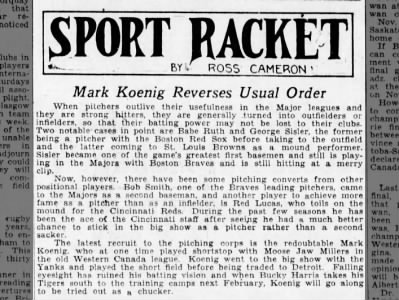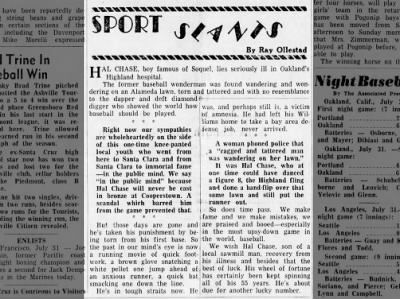According to Joe DiMaggio’s biography, the Yankee Clipper once was almost traded for Ted Williams. The thinking behind the proposed trade was that each icon would benefit from playing in the other’s home park. There may be something to this with DiMaggio whose offensive production was 8 percent better at Fenway Park than the original Yankee Stadium. Williams is another story. In 1941 when he became the most recent player to hit .400, Williams batted .428 at home. A different ballpark may have cost him. The stat converter on Baseball-Reference.com has Williams hitting .373, for instance, with the Boston Braves.
Not every hitter in baseball history has had Williams’ good fortune with his home park. Here are five men who may have hit .400 if they’d played in more hitters-friendly stadiums in years they approached history:
1. Tony Gwynn, 1994 and ’97: It’s nice Gwynn played his entire career– preps, college, and majors– in San Diego, but he paid a price for his loyalty. Playing for the Padres may have cost Gwynn .400 twice. There’s 1994 where Gwynn hit .394, the closest anyone’s come to .400 since 1941. In the majority of parks in the American League, where teams averaged 5.23 runs, 13 percent higher than the NL rate in 1994, the converter projects Gwynn hitting around .420. Gwynn would have topped .400 again in 1997 had he played for the Rockies. Playing home games that season at Coors Field, he’d have hit .414.
2. Rod Carew, 1977: Carew’s .388 for Minnesota converts to .400 in a number of other parks in 1977. One that stands out: Fulton County Stadium in Atlanta where Carew is projected to have hit .413 with 265 hits. Granted, he would have been on a team that finished 61-101, scored 678 runs and, for one inglorious game, featured owner Ted Turner as manager. Carew would have also had to contend with the pressures of playing every game before a national audience on TBS. Still, I can’t help but wonder what he might have accomplished in one of the great hitter’s parks of its day. And it’s worth noting that the Braves became a contender by the early ’80s. Maybe with Carew in town, that could have happened sooner.
3. George Brett, 1980: Brett hit .390 for the Royals, flirting with .400 for much of the second half and being above the mark as late as September 19. The stat converter has Brett finishing above .400 in 1980 for the Red Sox, Twins, Indians, Tigers, Mariners and Blue Jays. The converter, of course, isn’t infallible. We can rule out Seattle or Toronto, each recent expansion clubs at the time that barely topped 600 runs. The Twins seem unlikely as well, given their 666 runs and 86 OPS+ as a team. A .400 hitter needs a lively offense; the 1941 Red Sox, for one, scored 865 runs.
It’s counter-intuitive to take Brett away from a juggernaut like the 1980 Royals, who lost in the World Series. But Brett may have stood a better chance at .400 that season with Boston or Detroit. The converter has him topping .408 for either team. I like Brett’s chances in Boston most. Detroit scored more runs that season (830 to 757) and each team had a fine hitting park, though the Red Sox lineup gets the edge for star-power: Jim Rice, Fred Lynn, Carlton Fisk, Dwight Evans, Tony Perez and Carl Yastrzemski. With Brett substituting for Glenn Hoffman at thrid base, perhaps Boston would have fared better than 83-77 and fifth place in the AL East.
4. Jeff Bagwell, 1994: The Red Sox famously traded Boston native Bagwell while he was in the minors for aging reliever Larry Andersen, with the belief Bagwell wouldn’t beat out Scott Cooper at third base. Next to Babe Ruth for “No, No Nanette,” it’s maybe the worst trade in Red Sox history. Here’s Bagwell’s slash if he’d played his home games in ’94 at Fenway Park rather than the cavernous Astrodome: .401/.486/.811, to go with 44 home runs and 143 RBIs. (Favorite Bagwell stat from ’94? He hit better at home than on the road, .373 to .362. It’s one of the more underrated seasons in baseball history.)
5. Barry Bonds, 2002: When all is said and done, there is no finer use for the stat converter than seeing the kind of cartoonish numbers Bonds would have produced for the Colorado Rockies. There’s the 87 homers the converter projects him hitting for Colorado in 2001 or the 50-50 season he just misses out on in 1996. Then there’s the matter of the .370 batting average (with the is-this-real-life 268 OPS+) that Bonds offered while leading the Giants to the 2002 World Series. Playing for the Rockies instead in 2002, Bonds would have hit .401 with 53 homers and 133 RBIs.
Honorable mentions
Derek Jeter, 1999: Every time I see a mention of the stat converter from a major outlet, it’s generally to punch in numbers players would have offered on the 2000 Colorado Rockies. The ’99 Rockies actually offers slightly higher converted numbers, though I doubt this is widely understood. Take Jeter, who hit .349 for the Yankees in ’99. Playing for the Rockies instead, Jeter’s average rises to .391.
Ichiro Suzuki, 2004: The best season of Suzuki’s career had him batting .372 and breaking George Sisler’s hits record for the Mariners. Safeco Field may have short-changed Suzuki, though. The stat converter has the best contact hitter of his era hitting .398 with, get ready for it, 292 hits in 797 plate appearances for the Rangers in 2004. Alex Rodriguez’s preseason trade to the Yankees would quickly have become a distant memory.
Chipper Jones, 2008: Jones led the National League with a .364 batting average at 36, reminiscent of when 38-year-old Ted Williams hit an AL-best .388 in 1957. Playing at Fenway Park instead of Turner Field in 2008, Jones would nearly have matched the Splendid Splinter. The stat converter has Jones hitting .385, though I suspect the chance to serve as designated hitter on a regular basis might have pushed his average higher.
Joe Mauer, 2009: According to the stat converter, Mauer’s .365 batting average in his MVP season with the Twins becomes .386 for the Yankees.

